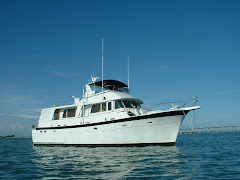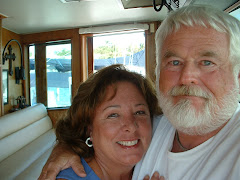We made our way to Peake’s Boatyard Travel-Lift on Monday morning, September 15th. The lift operators were very professional and efficient, and it still took three hours to get KINGDOM out of the water and settled on the jack-stands used in the yard for temporary storage and bottom-painting. As soon as the boat was ashore, still in the slings of the travel-lift, the bottom was scraped free of barnacles and pressure-washed before moving to the yard.
I had already made arrangements with Peake’s Yacht Services for the bottom paint work. They had assured me that this could be finished in five days, which is technically possible, if the work starts the same day. We checked into the on-site waterfront hotel, expecting to be there until Friday. The hotel is actually what we would call a “motel” in the U.S. – a tiny room, twin beds, small closet, bathroom, TV, and a powerful air conditioner. However, it was only $70 per day, so we felt we could afford it for a week or less. Best of all, on the second-floor verandah was the “Vespa” restaurant, which offered breakfast, lunch and dinner, with FREE INTERNET SERVICE.
I'm sorry that these pix are not in order, but maybe I can label them so they're understandable.
KINGDOM on the jack-stands in Peake's Boatyard

Did you ever see a prettier bottom?

The pilot house now glows with fresh varnish

KINGDOM's freshly polished and waxed hull sides

KINGDOM rises in the slings of Peake's Travel Lift

This is the scariest part- when the travel-lift begins moving...

KINGDOM takes a stroll... Notice her sistership "Never-Neverland" in the background

The waterfront verandah of the onsite motel at Peake's Boatyard

KINGDOM's freshly re-bedded windshields

Peake’s is a full service boatyard, with onsite contractors for virtually any repairs or maintenance that a boat could need. The downside is that the place is packed with boats this time of year, and project management leaves a bit to be desired. We engaged an onsite company, KNJ Yacht Services, to organize some of the other work we wanted done.
We needed a complete set of anodes. Anodes are made primarily of the relatively soft metal, zinc. When attached to underwater parts made of harder metals, they act as a “sacrificial” metal, slowly decomposing as electrolysis occurs between the water and metal parts. This prevents destruction by electrolysis of the critical steel, brass and bronze running gear, such as drive shafts, propellers, rudders, bow thrusters, etc. Depending on conditions, anodes must be replaced every year or less, or whenever they are approaching total disintegration.
We also needed a replacement or repair for the “clamshell” raw-water strainer for the air-conditioner intake.
We required a new “spur” for the portside driveshaft (a “spur” is basically a line-cutter that sits just ahead of the propeller. Its’ purpose is to keep the props from being fouled when we run over an unseen crab trap anchoring line, or other floating cordage; a not uncommon event.)
Our portside propeller needed to be straightened and balanced, due to a minor mishap with a small coral head in Solomon’s bay a few months ago.
All five of our front windshields need to be re-bedded and re-sealed.
While that work was in progress, we separately engaged local workers to undertake several other projects of a more cosmetic nature. We had the hull cleaned and polished from the waterline boot stripe up to the rub rails, which is almost impossible to do while the boat is in the water. We engaged the services of another crew led by “Uncle Sam” Haynes to completely restore the varnish in our pilothouse (this is the only area of the boat we had not restored or remodeled in Florida). We had a wood joinery craftsman replace two small areas of dry-rotted wood in the pilothouse. We tracked down and caulked two small but annoying water leaks in the pilothouse area. Another crew installed our new SSB Grounding Plate, to improve SSB Radio reception.
All of the above work was only possible while KINGDOM is out of the water and we were off the boat, so we tried to get it all done in a week. Pretty ambitious, not to mention overly optimistic! What were we thinking???
About bottom paint – for those wondering why it’s such a big deal. Boat hulls are under continuous attack from barnacles and algae growth. If left unchecked, barnacles can and will eat through the hard surface of the fiberglass hull, to the extent that bubbles form in the gelcoat, which can eventually burst and create gaps for seawater to seep into the layers of fiberglass, ultimately causing separation and de-lamination. Not a good thing. Apart from that, barnacle and algae growth adversely affect performance of the boat through the water. Specialized marine paints have been developed to combat these problems, and are widely known in the industry as “anti-fouling” paints. Their general purpose is to make it more difficult for these critters to adhere to the hull, and make it easier to remove those that do manage to attach themselves. These paints typically contain copper, zinc, and other trace metals and are designed to slowly slough off as the boat moves through the water, thus discouraging marine growth over time. That is why bottom paint must be re-applied every 12 to 18 months.
On Monday afternoon, September 29th, we were able to check out of Peake’s and “splashed” the boat. Back in the water, we motored back to Coral Cove Marina. Several small projects are still underway, but these can be finished while we are here and in the water.


